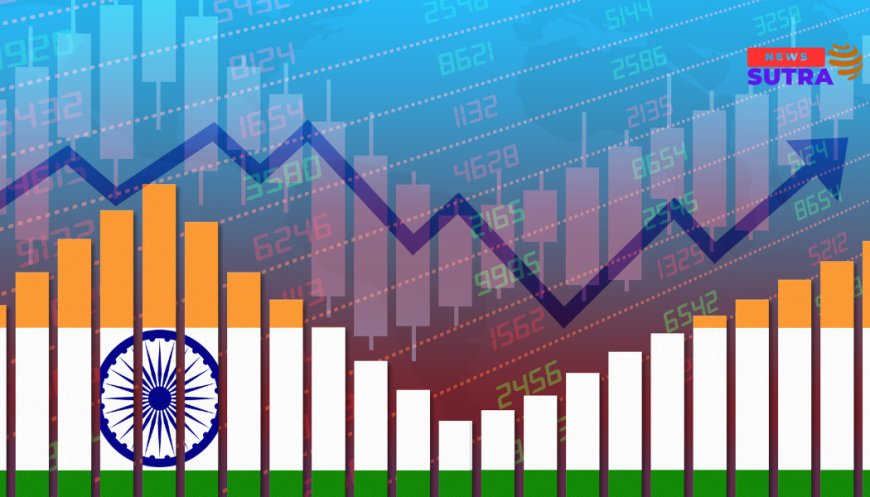India's Economic Surge: Q4 FY25 GDP Beats Expectations—What's Driving the Growth?
India's GDP growth in Q4 FY25 has exceeded forecasts, signaling strong economic momentum. Discover the key sectors and policy drivers behind this resurgence.

India’s economy has clocked a remarkable 7.8% GDP growth rate in Q4 of FY25, outperforming earlier forecasts and reaffirming the country’s strong recovery trajectory. According to the National Statistical Office (NSO), this surge was driven by robust performances in manufacturing, construction, agriculture, and consumer spending—indicators that the Indian economy is gaining significant traction post-pandemic and amid global headwinds.
But what exactly is powering this growth? Let’s break down the data, sectoral performance, and key macroeconomic trends that are contributing to India’s renewed economic strength.
Manufacturing and Industrial Output Rebound
One of the most substantial contributors to Q4 growth was the manufacturing sector, which posted a year-on-year increase of 9.2%, compared to just 4.3% in the same quarter last year. Policy initiatives such as the Production Linked Incentive (PLI) scheme have helped revive industrial output.
According to Invest India, India has seen a surge in electronics and auto component manufacturing, with major multinational investments backing the trend. The government's focus on “Make in India 2.0” is starting to bear fruit, improving not just capacity but also exports.
Infrastructure and Construction See Strong Uptick
The construction sector grew by 10.4%, fueled by massive public capital expenditure and infrastructure upgrades. Under the National Infrastructure Pipeline (NIP) and PM Gati Shakti Master Plan, highways, railways, and urban infrastructure projects received significant funding. These programs are designed to drive long-term economic productivity.
Reports from NITI Aayog indicate that over 75% of the NIP targets for FY25 were met ahead of schedule, with private sector participation also showing signs of recovery.
Agriculture Remains a Steady Pillar
Even as India’s economy diversifies, agriculture remains a stabilizing force, growing at 4.1% in Q4 FY25, up from 2.8% in the previous quarter. Government programs such as PM-KISAN and digital initiatives like eNAM have strengthened farm-to-market linkages.
The adoption of agritech—including precision farming and AI-driven crop forecasting—is gradually improving productivity. As per ICAR, agritech startups have helped farmers in states like Maharashtra, Punjab, and Karnataka boost yields by 12-18% year-over-year.
Consumption & Services Bounce Back
India’s private consumption rose by 5.8%, largely driven by improved urban demand and rising discretionary spending in metros and Tier-II cities. Sectors like hospitality, retail, aviation, and e-commerce saw a sharp uptick in activity, as indicated by the Services PMI, which touched 58.9 in March 2025, signaling strong expansion.
Digital commerce platforms such as ONDC have democratized online retail for smaller businesses, leading to wider participation from MSMEs in consumer markets.
Stable Monetary Policy and Fiscal Management
The Reserve Bank of India (RBI) played a crucial role in balancing inflation and liquidity without sacrificing growth. The central bank kept the repo rate steady at 6.50%, as inflation remained within the 4-6% tolerance band.
In its latest Monetary Policy Statement, the RBI cited a "favorable macroeconomic environment" with adequate forex reserves, moderated crude prices, and improving export competitiveness.
At the same time, the Finance Ministry has managed to maintain the fiscal deficit at 5.5% of GDP, in line with budgetary targets. Continued focus on capex while controlling revenue leakages helped maintain macroeconomic discipline.
Foreign Direct Investment and Global Confidence
India remains one of the most attractive investment destinations globally. According to the Department for Promotion of Industry and Internal Trade (DPIIT), FDI inflows touched $84 billion in FY25, the highest ever in a fiscal year. Key sectors attracting investments include renewable energy, semiconductors, fintech, and electric vehicles.
Global institutions like the IMF and World Bank have revised India's growth outlook upwards, with the IMF projecting India to remain the fastest-growing major economy in the world in 2025.
Risks to Watch: Geopolitics and Climate
While the outlook is largely optimistic, potential risks remain. Ongoing geopolitical tensions in West Asia, rising climate volatility, and a potential slowdown in global trade could challenge India’s external balance and rural income dynamics.
Experts warn that while the domestic fundamentals are strong, India must build economic resilience through diversification, sustainable growth models, and climate-adaptive infrastructure.
Conclusion: Momentum with Caution
India’s Q4 FY25 GDP performance is not just a rebound—it’s a statement of strength, policy clarity, and long-term vision. The combination of infrastructure investments, consumption recovery, and manufacturing incentives has laid a robust foundation for sustainable growth.
However, sustained momentum will depend on how effectively India manages its external vulnerabilities and continues reform in areas like labor laws, logistics, and capital markets.
As India eyes a $5 trillion economy milestone, the Q4 growth numbers are more than encouraging—they are a call to action.

















































